February 2009 Archives
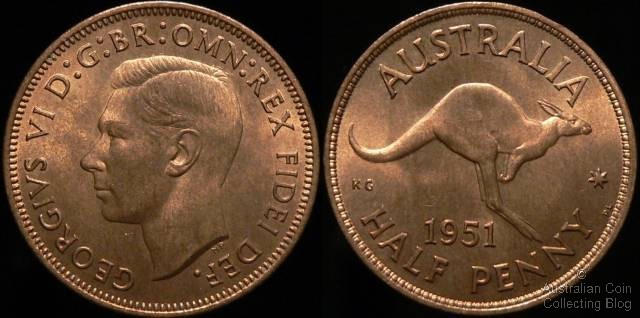
Australia 1951PL Half Penny
In 1951, due to capacity problems at the Royal Australian Mint, some coins were minted at the Royal Mint in London, England. The denominations minted by the Royal Mint in 1951 were the half penny, the penny, the threepence, and the sixpence. Note that each of these denominations was also struck in Australia in 1951. The coins minted in the UK were notably better struck than the coins in Australia and exhibited different rim beads and denticles. They were also marked with the mint mark 'PL' on the reverse of each coin. Above you can see a 1951PL half penny, the mint mark can be seen near the rim at about 4 o'clock on the reverse.
Now it had never really occured to me to wonder what the mintmark PL stood for. However, I am currently reading Collecting Australian Coins (Hanley and James 1966) and they explain the origins of this mintmark on page 88. It's interesting enough to quote verbatim here:
...these coins were mintmarked with PL on the reverse and in the 1951 Mint Annual Report says of this: "The same letters were used, as well as others, for the same purpose on coins struck at London during the Roman occupation....some suggest that P is an abbreviation of pecunia (money), others favour percussa (struck). Whatever be the extended form, however, the significance was the same in 1951 as in Roman times, that the coins were struck at the Mint in London."
The book doesnt mention what L stands for but obviously this is Latin for London. So we have two possibilities for what the PL stands for:
pecunia londinii - money of London
percussa londinio - struck at London
It is amazing to think that here we have a connection between the coins issued for circulation in Australia in the early 1950's and the coins struck in London nearly 2000 years ago! In fact, a little bit of Google research (from here) reveals that the PL mintmark was used only for a short period from about 300AD to 326AD and for a few more years after 380AD. This is yet another example of how the wonderful hobby of coin collecting helps to shed light on the history of Australia and even on the history of other countries going back thousands of years.
As you would have read in Part 1, the proof dollar coin manufactured in the sets by the RAM was the dancing man dollar and not the standard design mob of roos in 2005. But a number of proof sets in 2006 were released with an error including a 2005 dated mob of roos dollar. This 2005 proof mob of roos coin just isn't meant to exist!
There has been much debate in numismatic circles whether or not the term "mule" is the correct definition for this coin, or in fact it is simply a date error. What I always understood as the definition of a mule is that it is a coin struck from dies not intended to be paired together. Now you can see where the doubt comes into the label with "dies not intended to be paired together". The 2005 Elizabeth II one dollar obverse die was never intended to be paired with the standard mob of roos design for the year 2005. Very simple. But...... it was the standard design issued many other years so for any other year it was just a regular coin. Therefore is it just a date error?
An example of a genuine mule coin is the 2000 $1/10 cent mule where the obverse die of the 10 cent coin was accidently struck on the dollar reverse die and released into circulation. There is no denying that this is a true mule coin.
The problems with labeling the 2005 proof mob of roos dollar is in how you understand the wording of the definition of the term "mule". Coming away from a very long discussion on the now defunct aussiecoins forum I think numismatists agree there will never be closure on this question and we'll just agree to have our own opinions on what we perceive the definition to mean.
If the Royal Australian Mint come forward and recognize this error we might only then have an official term to use to describe this coin.
In 2005 the Royal Australian Mint (RAM) issued coin sets with the theme of the 60th anniversary of the end of the WWII. This year the issued sets included the commemorative coins issued for that year and not the standard issue designs. Included in the uncirculated set, proof set, baby set and the wedding sets were a special 20c featuring an Australian soldier, an ex-prisoner of war "coming home" from the war to his family after many years apart. The "remembrance" 50 cent depicts a digger, a priest and graves capturing the sombre and reflective mood of remembrance and the enormous cost of all the conflicts. The iconic image of "the dancing man" recorded during victory celebrations at the end of the Second World War is the theme captured on the Peace one dollar.
In 2006 the Royal Australian Mint released sets in the theme of 40 years since the introduction of decimal currency so this year would mark 40 years since the pound, shillings and pence were withdrawn and dollars and cents introduced in 1966. The set would reproduce the 1 cent and 2 cent coins originally issued but withdrawn from circulation in 1991. It would also reproduce the round silver 50 cent piece as issued only for the first year in 1966.
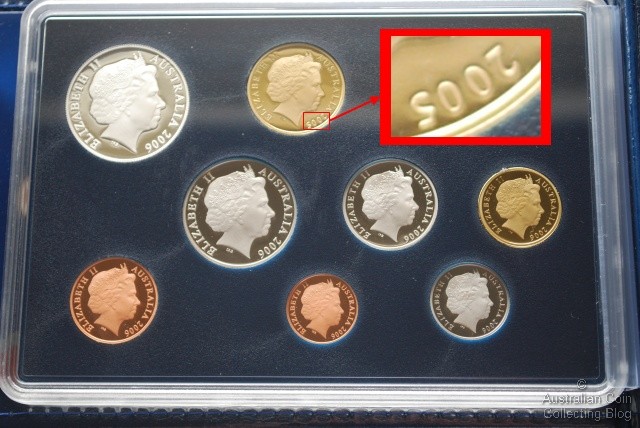
Australia 2006 Proof Set - Highlighting Date of 2005 Proof Mule
Something went awry at the mint sometime during the year of production of the 2006 proof sets. In 2006 a customer of Downie's purchased a 2006 proof set and when they looked at the set they noticed that it in fact wasn't a complete year set of 2006, it accidently included a proof 1 dollar coin from 2005. The customer in thinking they got a faulty set promptly returned it to Downie's to swap for an accurate set. Now if you had any knowledge of coin collecting and were following the coin issues you would probably faint with excitement if this happened to you.
As the information in the 2005/2006 proof coin set entry states the proof $1 coin of 2005 was meant to be the dancing man dollar. IN FACT no proof mob of roos standard design coin for this year was meant to be produced. Downie's promptly checked all it's sets and approximately 20 of these sets were found. They were then put in their monthly magazine for a tidy sum of $1995 each, really just a number they pulled out of a hat I think , whether or not they expected to sell them at that price it was the precedent to be set. Considering issue price was just $80 personally I thought this was a bit steep. So, those who procrastinated missed out as these 20 sets sold in a record time, as I recall only a day or 2 they were gone. It was now a frenzy for every other collector to check their sets and a few other sets were found in the Brisbane area. To my knowledge around 40 of these sets are known to exist. A few sets sold in the months after this on eBay fetching around $3000.
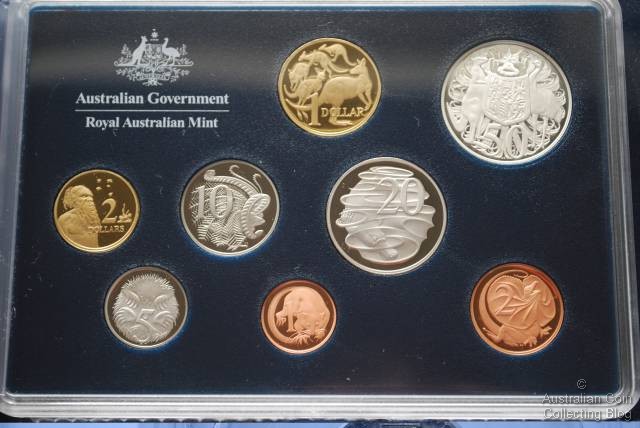
Australia 2006 Proof Set - Note Mob of Roos Reverse on Dollar Coin
This error hasn't been officially recognized by the RAM but having seen one of these sets I can assure you they do exist. This is a standard design coin if you saw this coin you would pass it off as a normal issue.
The RAM did in fact release some standard mob of roos designed 2005 dollars into circulation but the proof coin is different. As the design in the proof sets is the dancing man dollar the mob of roos design for the year 2005 just isn't meant to exist. The numismatic term "mule" has been used to described this error coin but is that a correct definition? I will discuss this in part 2 of the 2005 Proof Mob of Roos dollar debate.
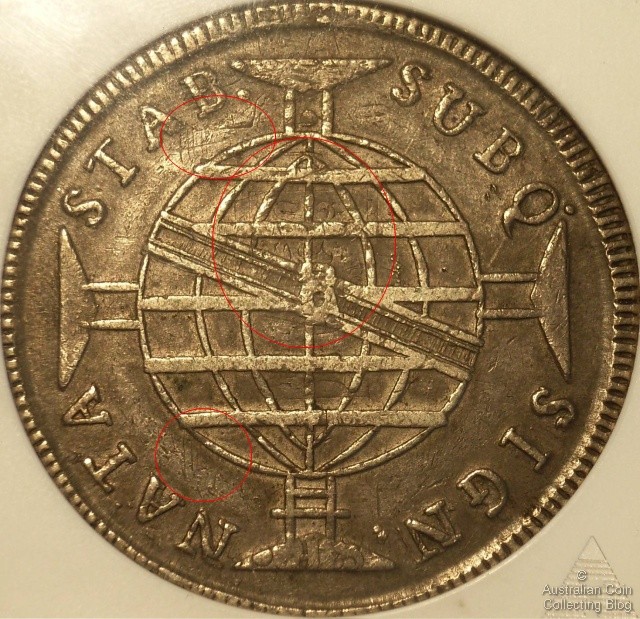
Brazil 1815 960 Reis - Overstruck on Spanish 8 Reale
During the history of minting coins sometimes, deliberately or accidentally, coins have been made by using existing coins as raw material. Basically this means that an existing coin with an existing design has a new design stamped onto it. There are several reasons why this may have happened. In ancient times older coins celebrating events that were no longer politically acceptable or sporting slogans that opposed the current government were often collected up and overstruck with a new designs or simply overstamped to obliterate offending material. Overstruck Roman coinage is quite common, with regional rulers sometimes overstriking ciruclating coinage with their own name or initials to help spread their power base.
In more modern times a coin may have been over-struck with the same design because the first coin was poorly made or accidentally during the production process (the double struck coin error). Sometimes in periods of currency shortages a government would purchase a large number of coins from another country overstamp them with their own design giving them a local value and releasing them into circulation. One of the best known examples of this was the so called 'Bank Dollars' of Great Britain in the late 18th and early 19th centuries. The Bank of England bought up a large number of Spanish colonial 8 reale coins and initially countermarked them with a small oval shaped counterstamp of King George III's portrait. These countermarked dollars were valued at 4s9d. Later the Bank invested in full sized dies and overstruck the 8R design completely producing the 'bank dollars' valued at 5s. These coins portrayed George III on the obverse and a seated Britannia in an oval setting with the legend 'Bank of England' on the reverse.
Other well known examples of overstruck coins include the double rupees of India, the holey dollars of Australia, and the 960 Reis coins of Brazil. All of these coins used the Spanish colonial 8 reale as the host coin overstruck with a local coin design. At the top of this post you can see a Brazillian 1815 960 Reis with traces of the host 8 Reale coin circled.
If you're a coin collector and frequent internet coin forums then often you'll hear about a coin being 'well struck' or 'struck up' or 'having a good strike'. On the flip side you may hear of a coin 'having a weak strike', or 'not being struck up', or 'having a flat strike', or simply being 'poorly struck'. What exactly does this mean?
At it's most basic level when a coin is made or 'struck' a flat disk of metal is compressed between two dies with a great deal of pressure. The pressure is such that the metal moves to fill in the spaces or designs on the dies and the coin is formed. Milled coins use a third component of the coin called the collar to restrain the lateral metal movement of the coin blank and produce a coin of a uniform diameter. Sometimes the collar imparts a design on the edge of the coin, sometimes it does not.
When the metal of a coin blank fails to move sufficiently to fill in all of the design elements of the coin die then it is not fully struck, and some parts of the coin design will be poorly formed or even missing entirely. When the coin blank does fill the design elements fully and the coin truly reflects the intended design then it is well struck and fully formed. The reasons for poorly struck coins usually fall back to striking pressure and die wear. If striking pressure is too low then the coin will not be fully struck up. Striking pressure may be too low because the coin manufacturers wish to extend the life of the coin dies, or they may be lowered towards the end of a dies life to preserve it. When a die becomes worn it may even lose certain design features that simply wear off or are polished off during die maintenance. Technically coins struck from such worn dies are not neccesarily weakly struck, they are 'struck from worn dies'.

Weakly Struck Coins
The Australian Penny from 1953 to 1964 was struck with a portrait of Queen Elizabeth II of the United Kingdom. The ear of her portrait happens to be the high point of the obverse design and coincidentally is opposite a high point of the reverse design. This means that the metal movement required to fill the ear is quite large and the design feature is a good indicator of strength of strike. You can see in the image above the most weakly struck coin on the left progressing to the right with better struck coins. The ear is almost entirely missing on the first coin and is still not fully formed in the last coin.

Strongly Struck Coins
The image above shows much better struck coins. The coin on the left shows a fully struck up ear, but the design features are not completely sharp. The quality of strike improves to the right with the last coin being what I would call fully struck. It's a matter of conjecture with the last two coins as to which is better struck, and really it could be the quality of the photo that determines my judgement. However, the last coin shows more precise hair detail and overall sharper features and I believe it is the best struck coin.
I hope that explains what 'quality of strike' means!
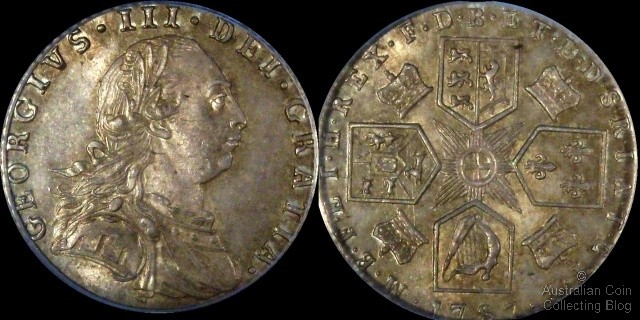
1787 Proclamation Sixpence - Hearts Variety
In my previous entry about Australian proclamation coins I mentioned the 1787 Shilling of Great Britain which was valued at 1s 1d in the proclamation. The brother coin to the 1787 Shilling, the 1787 Sixpence, while not mentioned explicitly in the proclamation was almost certainly traded at the same time for 6d 1/2d. Designed by Luis Pingo and minted from about 3 grams of sterling silver and 21 millimetres in diameter you can see an example of the 1787 proclamation sixpence above. Silver coins were only minted occasionally under George III in the 18th century and 1787 saw the largest mintage of shillings and sixpences until 1816 and the great re-coinage.
The obverse depicts the older laureate bust of George III. The 1787 6d was minted with a single obverse.
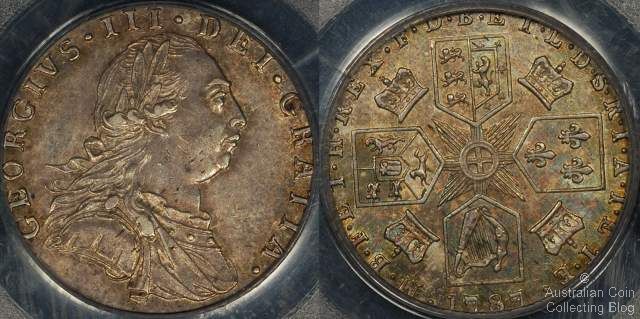
1787 Proclamation Sixpence - No Hearts Variety
The reverse depicts cruciform shields with coats of arms and cruciform crowns. The reverse came in two varieties, with or without the semee of hearts in the Hannoverian coat of arms. At the top of this post you can see the with hearts variety of this coin, and above you can see the no hearts variety. The Hannoverian arms are at the 9pm position in the images.
I would use the same principles when purchasing one of these coins as I suggested with the proclamation shilling. Generally originality of surfaces is the key to eye appeal with these coins. A blast white coin is a sign of dipping and I personally would avoid a coin like this. The images above show two examples of coins with very different surfaces. The top coin is a mint state example with probably an old cleaning that is starting to re-tone with a nice golden glow to the coin. The second coin looks to have much more original surfaces, it is a VF example but the violet/steel toning it has make it a more attractive example that the first coin.
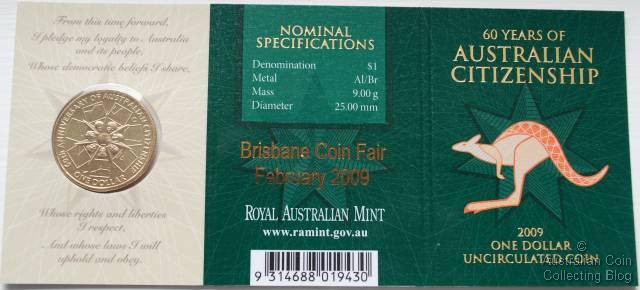
February 2009 Brisbane Coin Fair Overprint
The Brisbane Coin Fair run by VP Coins (Vic Power) is by all reports an excellent coin show to visit. It is attended by a lot of dealers, held twice a year and many people say is a lot better than some of the ANDA coin shows held around Australia. For the show in February 2008, as a marketing exercise Vic overprinted 973 Coat of Arms mintmark dollar coin folders with "Brisbane Coin Fair February 2008". Now these were just the general issue Coat of Arms "C" mintmark dollars in their packaging, but the folder was over-printed. He repeated this exercise in October 2008 (with COA "B" privy coins- 1089 issued) and again this month but with the new 60 Years of Australian Citizenship Dollar "C" mintmark. You can see one of the overprinted coin folders from this months show above, 1493 of these were issued at the show.
These overprint folders present an interesting conundrum to the collectors of Australian $1 coins. Namely, should you collect them or not? They are, after all, the same coins you can get in non-overprinted folders. So in reality all you are collecting if you do choose to get them is the packaging. There are really just three arguments for collecting them.
- Firstly, they are dollar related, and if one was to be pedantic, for completeness, then you do require them for a truly comprehensive collection.
- The second argument is the mostly unsubstantiated claim that these overprints are recognised by the Royal Australian Mint (in fact some of the production of the first overprint was supposedly done by the RAM). The claims are restricted to 'someone read in the Australian Coin and Banknotes magazine that they were recognised' and 'the RAM is supposed to have an overprint in their museum'. Neither of these claims is particularly strong nor supported by any real proof.
- The final reason for wanting these overprints would be purely financial. These overprints are scarce, with just 1000-1500 printed for each show. They are available to people who attend the shows for just $6 or so, and sell on eBay for $20. The February 2008 overprint was getting $40-$50 at the peak of it's prices.
Well what are the reasons for not wanting to collect them? Just one really. They are not a unique coin, they are just packaging. Silverfish food. As someone I know says, it's just 'packyboxitis' on the behalf of collectors who want them. If you're collecting these why not the other varied packaging that dollar coins come in, the various VIP issues, Berlin Coin Fair overprints, mint sets, proof sets, the list goes on.
What do I think? Well I have one of each of the overprints for completeness, but if the prices for them in the secondary market had reached exorbitant levels I would not have bothered. They are collectable and interesting, but I am not really sure they should comprise part of what I'd call an official dollar coin collection.
I've only been a coin collector for the last three years, but I really feel like I have joined the hobby at an important point in it's history in Australia. It has become apparent to me in the last year that slabbing Australian coins is really gaining momentum. I can recall going to an ANDA show in September 2007 and hardly seeing a slabbed coin at all. Just 6 months later at another show there were at least two dealers with inventory that was largely slabbed. Roll forward a year and at a small regional show there was one dealer with his inventory entirely slabbed. Then there is the rise of the 'slabbed dealers' as I like to think of them, dealers that seem to largely restrict themselves to slabbed inventory that they sell via their websites, eBay, or via a mailing list. These sorts of dealers have really fallen out of the woodwork in the last year, with at least one older established dealer leading the charge with an almost entire inventory slabbed by PCGS.
Then we see the current topics of discussion on the various internet forums. Lately there has been a discussion on the eBay Australia forums titled 'Slabs are the future of numismatics'. The thread is long but makes for interesting reading, with some clear advocates of the practice and some clear opponents. It's interesting to note that one of the posters in there is an established ANDA dealer and has an established history as a vocal opponent of slabbing. Funnily enough in my 'younger' coin collecting days I bought two coins from him, one of which turned out to be cleaned and the other damaged, and both wouldn't come within a bulls roar of getting into a PCGS slab. Buying them was my fault entirely but both were graded by this dealer with grades that have turned out to be entirely spurious.
Then today I notice an interesting post on Andrew Crellin's Blog over at Sterling and Currency Numismatics. There's a bunch of stuff in there that I agree with. Slabs will help the liquidity of the market, they will make it easier for new collectors to buy with confidence, and yes they will help the sight unseen coin market. But the most important thing that Andrew says, is to remember that you are buying the little round disc of metal in the slab, not the slab itself. That should be the thing you spend most of your time looking at, not the grade on the printed label.
Just as a small aside, I've noted a change in my buying behaviour. Basically in the last year I've stopped buying higher grade coins from eBay because I am usually disappointed in them, and prefer to see the coins in hand first. However, in the last couple of weeks I've found myself bidding for and winning a couple of slabbed coins. It didn't really occur to me until afterwards, that there was no way in the world I would have bought those coins from eBay if they were not slabbed by one of the three major TPG's. So, while I am hardly a good sample size as proof of something, the slabbing of these coins certainly influenced my purchasing of them, and perhaps the rest of the Australian coin collecting market will begin to feel the same.
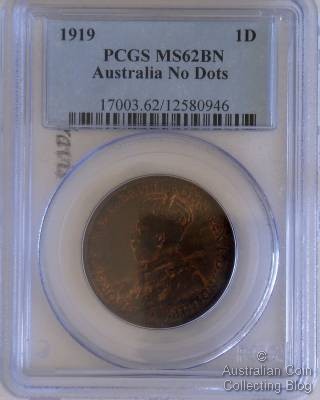
PCGS MS62 Australia Penny
Slabbed Australian coins are a relatively new thing in the Australian coin market. Slabbing coins has been common in the USA since the 1970's but it really has only been in the last year or two that numbers of slabbed Australian coins have come onto the market. The majority of slabbed coins that I have seen have been in PCGS or NGC plastic. I tend to see mostly pre-decimal coins (siver, gold, and copper) in PCGS plastic and sovereigns, modern NCLT and bullion issues issues in NGC slabs. I can only guess why this might be the case, with coin submitters believing that PCGS does a better job with commonwealth coins and there being no appreciable difference with gold or modern releases. NGC is cheaper to have coins graded so if there is no perceived difference in grading quality then collectors must send their coins there!
Regarding the quality of coins in slabs, I've seen everything from true rarities to other coins that leave you scratching your head as to why it is even slabbed in the first place. As always I live by the axiom of buying the coin not the holder. I have been to coin shows where I have seen dozens of coins in PCGS slabs and I wouldn't buy one of them, fingerprints, ugly toning, waterspots, traces of PVC damage or verdigris, and ugly debris stuck to the coins! Now, while none of these are serious problems they do detract from the eye appeal of the coin and I'd always pass on them unless they truly are best of breed! The cost of slabbed coins in Australia is still at a premium, some dealers pitch them at the premium end of the market and expect outrageous prices for coins that have the top grade for the type. The term used is "finest known" which of course is finest known in a slab which implies the best coin in existence but with so few Aussie coins slabbed by PCGS or NGC this is simply misleading. As always, caveat emptor and make sure you know what you are buying!!!
Good sources of slabbed coins in Australia include The Purple Penny ,Drake Sterling, Pacific Rim Coins, and Walter Eigner Numismatics. Of course eBay always has a few slabbed Australian coins listed and Northeast Numismatics in the USA has a variety of (mostly NGC) slabbed Australian coins. It can also be worth looking at various Australian coin auctions because slabbed coins are often appearing in these catalogues these days!
There are often very slight differences in the dies used for our mass-produced circulating decimal currency. It is not clear whether this is accidental or merely just oversight or perhaps mint workers not paying careful enough attention to details. With a production run of one set of dies running to 100,000 or 200,000 coins usually a years mintage is produced from a number of different die pairings. Minor differences called varieties can be noted from studying a large number of coins of the same design from each year.
The most notable decimal variety and the one with the most worth is the 1966 wavy 2 20 cent coin. A number of our 20 cent of that year were minted in London and one of the numerous dies used for striking had a wave at the top of the baseline of the 2. If you were to find one of these in your change it could easily be worth $200 with high grade examples fetching thousands.
Another interesting example is the Coat of Arms reverse design of the 50 cent. When the design was transferred from master punches to working dies a small detail was occasionally overlooked. Behind the emu's head there are two horizontal lines which exist on some coins and not others - possibly these created a weakness in the dies causing die breaks so were ground off some dies. These are known as the double bar variety 50 cent. If you find for example a 1979 example of a 50 cent piece with these double bars it could easily be worth double that of it's non-barred counterpart.
Other varieties worth looking out for are:
- 2000 Millenuim incuse flag 50 cent
- Cuds causing extra features on designs such as lips on the Queen or double chins. These can occur anywhere on any design.
- Die cracks or breaks where there is a line on the design occurring uniquely on that coin. With a die breaking each succeeding coin may have a greater degree of the die crack until the die breaks and is replaced.
- 1968 2 cent some examples are missing the designers initials SD
- 2004 20 cent obverse there are large head and small head types
- 5 cent small and large echidna reverses
Noted above are the most well-known examples of varieties with more being discovered all the time. Keen collectors can't wait for new issues and they obtain bags and rolls of coins to inspect in great detail to try to detect minor die variations. The more spectacular the differences in the variety the more value the coin has but small differences don't generally fetch much premium above face value.
Interesting and extremely rare Australian decimal coins include the 1981 scalloped 20 cent which is a 20 cent design accidently minted on a Hong Kong $2 planchet, there are 6 examples of these known to exist.
Occasionally a coin of a different year finds it's way into a years mint or proof set. In a very few examples of the 2006 proof set it has been found that the dollar included was a 2005 mob of roos coin. Although it has not been officially recognized by the Royal Australian Mint it is a clear error, as there were no other 2005 proof mob of roo dollars released. The proof dollar minted for the 2005 set was the Dancing Man dollar. This Mule is definitely a rarity with only around 40 known sets to date.
A possibly unique error that surfaced at a Downie's auction in 2007 was a bi-metal 20 cent piece. This was said to have been removed from an Armaguard security roll. The only practical explanation for this is that a foreign bi-metal blank got mixed in with a batch of our blanks which the RAM sources from Korea. This coin which cost it's owner 20 cent was sold for $3600 + comm.
It is interesting when reading the RAM official mintage reports for each year, in 1988 a 50 cent Coat of Arms issue is just not mentioned. The issue for 1988 was the commemorative Bicentennial design. Surfacing in an IAG auction in August 2006 was just that, an accidental 1988 Coat of Arms coin selling for $5400 + commission. This has also happened in 1977 when the 50 cent was minted with a reverse design commemorating the 25th anniversary of the coronation of Queen Elizabeth. These coins can be officially labelled as mule error coins as they were struck from dies not intended to be paired together (for that year anyway).
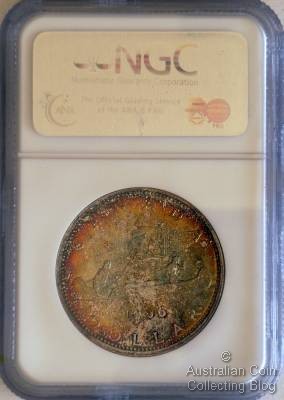
NGC MS62 Canada 1966 Voyageur Dollar
It wont be long after you start collecting coins that you hear the term 'slabbed coin'. This is especially so if you are in the United States where slabbed coins dominate the market. Call it slabbing, encapsulation, putting in plastic, or entombing, it is all the same thing. Basically it involves sending your 'raw' (non slabbed coins) to a third party grading company such as PCGS, and they grade the coin, place it in a 'slab' with a label and send it back to you.
The slabs themselves are hard plastic containers that are sonically sealed to prevent tampering and to provide a chemically inert environment for the coin. Prevention of tampering is important to prevent coin substitution. The inert environment and durable holder ensure that the coin stays in the same condition it was when first placed in the holder. The slabs themselves should include a label that informs the viewer of the coin what the grade of the coin is, the company that slabbed it, and usually a barcode that gives the coin type and the actual coin a unique reference number. Often the slabs will include some sort of holographic sticker or identifying mark that is hard to reproduce, this is to prevent the rather new practice of counterfeiting slabs. Yes, that happens, people will counterfeit a slab and label and try to pass off a low grade or counterfeit coin as something else!
There are a few things to be aware of when purchasing slabbed coins. Firstly, only buy from reputable slabbing companies such as NGC or PCGS or ANACS. There have been a slew of bad TPG's start up over the years, and just because a coin is entombed in plastic doesn't mean it is what the label says it is or it is the grade it says it is. The second thing to be aware of, is that even if a coin is slabbed by one of the better companies dont buy just because of what it says on the label. The is the coin collectors axiom, "buy the coin not the plastic". There are a couple of reasons for this. The TPG's can and do make mistakes with grades, they can overgrade or undergrade coins. The other reason is that the label doesnt describe everything, it wont tell you if there is a fingerprint on the coin, or if the toning is ugly, or if the strike is weak.
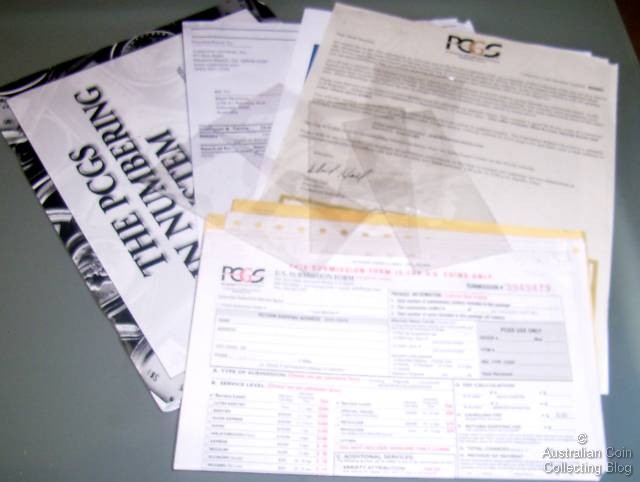
PCGS New Member Pack
I've just been going through the process of making my first submission of coins for slabbing to PCGS (The Professional Coin Grading Service). If you are not sure what this means it might be worth taking a look a the short series of posts I made about Third Party Grading Companies. Because I am based in Australia, and the process of submitting coins seems to be, well, rather bureaucratic this hasn't actually been the easiest thing to do.
Firstly, to submit coins to PCGS you must either join their member program or use a PCGS Authorized dealer to submit the coins for you. I chose to submit the coins myself because there's no authorized dealer in the city I live in. The dealer I have used in the past to submit coins for me had decided to stop submitting coins for the time being because of the poor Australian / US Dollar exchange rate. So, I decided to join up with PCGSs 'collectors club' and submit some coins myself. The Collectors Club includes three levels of membership. Each level gives you a number of free submissions each year as well as access to different features of the PCGS website, including the population report and PCGS price guide. Membership lasts for one year and includes a free quarterly grading specials (usually a US coin of some sort).
PCGS were offering discounted memberships in late 2008 so I decided to join up with Platinum membership which entitled me to 8 free 'regular' coin grading submissions. A 'regular' submission allows you to submit any coin worth less than US$3,000 as long as it is not a mint error or special issue. Free submissions sound great, but there is still a handling charge for the free submissions ($8 or so per order) and you still have to pay for insured shipping to and from PCGS. This is not too bad in North America, but down here in Australia you are looking at at least US$50 for just return shipping which is about AUD$75 at time of writing. So free isn't quite free, but still, regular submissions are worth US$30 each and the discounted joining fee was $180, so it was pretty good value.
Upon joining PCGS send out a new members pack containing all that you should need to make your first submission and new member information. This pack only took a couple of weeks to arrive here in Australia, which considering it was the Christmas / New Year period was pretty darn good. The pack contained the free submission voucher, detailed coin submission instructions, 8 2.5" mylar flips and adhesive labels, 3 submission forms, and the catalog of their coin numbering system. You can see the contents of the pack in the image at the start of this post. The 'US Centric' nature of PCGS really shone out with the member pack. The submission forms were all US Coin submission forms, and the catalog of their coin numbering system was for US coins only. So essentially these two items were useless to me because I wont be submitting many, if any, US coins to PCGS. PCGS should really allow new members to select if they will be submitting world or US coins at time of joining and the new member packs should be tailored accordingly. There's more coins in the world than simply US coins, and the number of world coins submitted to PCGS will only grow, and they should be preparing for this now, not later!
In the next part of this series I'll cover the submission process, including packaging the coins and filling out the forms. In later parts I'll cover the coins I'll submit and have a go at grading them so I can compare these grades with the grades returned from PCGS. Expected turn-around time for the coins is 40-60 days so I'll have plenty of time to think about it!


